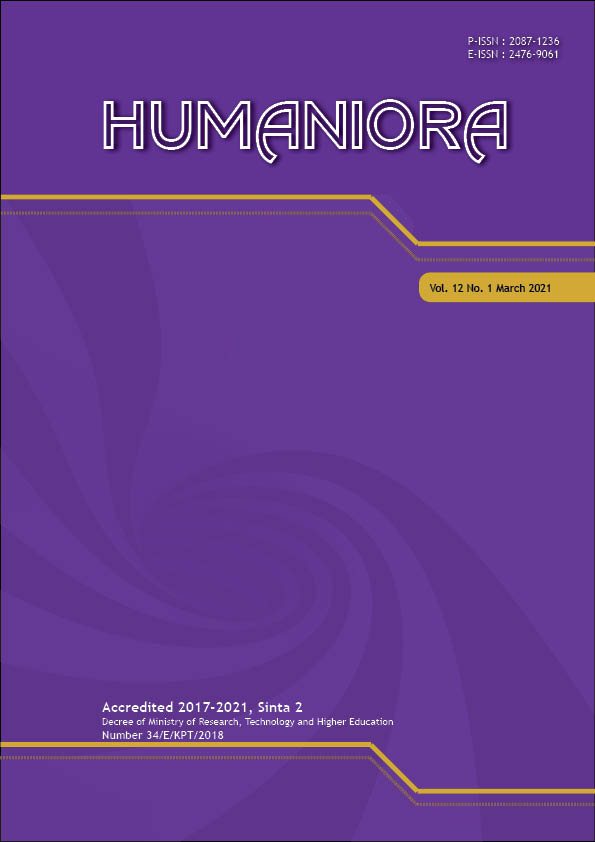Warm Colors, the Encouragement
DOI:
https://doi.org/10.21512/humaniora.v12i1.6973Keywords:
warm colors, cultural meanings, encouragement symbolAbstract
The research discussed the warm colors, such as yellow, orange, and red, as individual colors with a composition that could have a different impact on color connoisseurs depending on the background and context. The color was one design element that was rarely noticed but often used in everyday life. Color adds not only the beauty of an object but also the ability to manipulate the eyes and mind, often used to communicate without words. Using the right color at the right time and place could quickly send a message that was both fun and sad. The same color could mean different things in different cultural, social, economic, and political settings. Different cultures endowed color with different meanings depending on many things. As for color users, it was good to understand the effects of colors that were likely to occur to minimize the negative things. The research method applied was a qualitative narrative by collecting data from the literature, interviewing users and connoisseurs of color, observing, and analyzed. It is found that warm colors are often interpreted as bad things for some people in Jakarta, but they can also become symbols of courage and passion. It is hoped that these research results can be used as a rationale for making design work.
References
Danesi, M. (2004). Messages, signs, and meanings: A basic textbook in Semiotics and Communication Theory (3nd Ed). Toronto: Canadian Scholars’ Press Inc.
Elliot, A. J. (2015). Color and psychological functioning: a review of theoretical and empirical work. Frontiers in Psychology, 6, 1-8. https://doi.org/10.3389/fpsyg.2015.00368.
Green-Armytage, P. (2017). More than colour - dimensions of light and appearance. Journal of the International Colour Association, 17, 1-27.
Hoed, B. H. (2011). Semiotik dan dinamika sosial budaya. Depok: Komunitas Bambu.
Kumar, R. (2016). A note on colour psychology of Indian and Chinese culture and possible impact on advertising. In India China and The New World Order. Odisha, India. pp. 1-10.
Kuniecki, M., Pilarczyk, J., & Wichary, S. (2015). The color red attracts attention in an emotional context: An ERP study. Frontiers in Human Neuroscience, 9, 1-14. https://doi.org/https://doi.org/10.3389/fnhum.2015.00212.
Lampu Edison. (2020). Arti warna menurut berbagai budaya di Indonesia (Bagian 1). Retrieved from https://kumparan.com/lampu-edison/arti-warna-menurut-berbagai-budaya-di-indonesia-bagian-1-1toanv7601c/full.
Leo. (2019). Tiga ciri dan makna desain seragam Bank yang ada di Indonesia. Retrieved from http://craiovaonline.com/fashion/3-ciri-dan-makna-desain-seragam-bank-yang-ada-di-indonesia/.
Morton, J. L. (2021a). Orange - The meanings of orange. Retrieved from https://www.colormatters.com/color-and-marketing/59-color-symbolism/the-meanings-of-colors#.
Morton, J. L. (2021b). Red - The meanings of red. Retrieved from https://www.colormatters.com/the-meanings-of-colors/red.
Pettersson, R. (1982). Cultural differences in the perception of image and color in pictures. Educational Communication and Technology, 30(1), 41-53. https://doi.org/10.1007/BF02766547.
Piqueras-Fiszman, B., & Spence, C. (2014). Colour, pleasantness, and consumption behaviour within a meal. Appetite, 75, 165-172. https://doi.org/10.1016/j.appet.2014.01.004.
Purbasari, M., & Jakti, D. R. (2011). Khazana warna berdasarkan hasana alam dan budaya Nusantara (1). Humaniora: Language, People, Art, and Communicaiton Studies, 2(1), 722-730. https://doi.org/https://doi.org/10.21512/humaniora.v2i1.3089.
Purbasari, M., & Jakti, D. R. (2014). Warna dingin si pemberi nyaman. Humaniora: Language, People, Art, and Communicaiton Studies, 5(1), 357-366. https://doi.org/https://doi.org/10.21512/humaniora.v5i1.3034.
Purbasari, M., Marianto, M. D., & Burhan, M. A. (2016). The dynamic of Betawi in colors. Mudra, 31(3), 384-392. https://doi.org/https://doi.org/10.31091/mudra.v31i3.59.
Rossi, M., Rizzi, A., Bonanomi, C., & Siniscalco, A. (2018). Color: An experiential path between theory and practice. Journal of the International Colour Association, 22, 34-40.
Rudiyanto, G. (2011). Periodisasi pola-pola perubahan pada tenun ulos Batak Toba di Sumatera Utara dan tenun gringsing di Tenganan Bali dari abad ke-19 sampai abad ke-20. Dimensi, 8(2), 63-77. https://doi.org/http://dx.doi.org/10.25105/dim.v8i2.
Scoot, D. (2018). Color and light – What is color temperature. Retrieved from https://drawpaintacademy.com/what-is-color-temperature/.
Sevinc, K., & Osueke, K. K. (2014). The effects of color on the moods of college students. Sage Open, 4(1), 1-12. https://doi.org/10.1177/2158244014525423.
Smith, K. (2019a). Color symbolism and meaning of orange. Retrieved on January 9, 2021 from https://www.sensationalcolor.com/meaning-of-orange/.
Smith, K. (2019b). Color symbolism and meaning of yellow. Retrieved on January 9, 2021 from https://www.sensationalcolor.com/meaning-of-yellow/.
Wahidiyat, M. P., & Tabroni, I. (2020). Color game on ondel-ondel as cultural education media for children. Capture, 12(1), 87-95. https://doi.org/https://doi.org/10.33153/capture.v12i1.3263.
Widyaningrum, G. L. (2019). Dari India hingga Afrika, ini makna warna di beberapa negara dunia. Retrieved on https://nationalgeographic.grid.id/read/131665120/dari-india-hingga-afrika-ini-makna-warna-di-beberapa-negara-dunia?page=all.
Woelandhary, A. D. (2019). Unsur rupa dan makna pada busana pengantin Betawi. Jurnal Budaya Nusantara, 3(1), 1-11. https://doi.org/10.36456/b.nusantara.vol3.no1.a2109.
Downloads
Published
How to Cite
Issue
Section
License
Copyright (c) 2021 Mita Purbasari Wahidiyat

This work is licensed under a Creative Commons Attribution-ShareAlike 4.0 International License.
Authors who publish with this journal agree to the following terms:
a. Authors retain copyright and grant the journal right of first publication with the work simultaneously licensed under a Creative Commons Attribution License - Share Alike that allows others to share the work with an acknowledgment of the work's authorship and initial publication in this journal.
b. Authors are able to enter into separate, additional contractual arrangements for the non-exclusive distribution of the journal's published version of the work (e.g., post it to an institutional repository or publish it in a book), with an acknowledgment of its initial publication in this journal.
c. Authors are permitted and encouraged to post their work online (e.g., in institutional repositories or on their website) prior to and during the submission process, as it can lead to productive exchanges, as well as earlier and greater citation of published work.
USER RIGHTS
All articles published Open Access will be immediately and permanently free for everyone to read and download. We are continuously working with our author communities to select the best choice of license options, currently being defined for this journal as follows: Creative Commons Attribution-Share Alike (CC BY-SA)




















